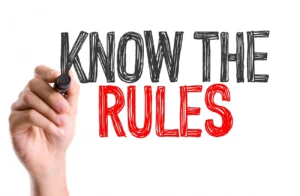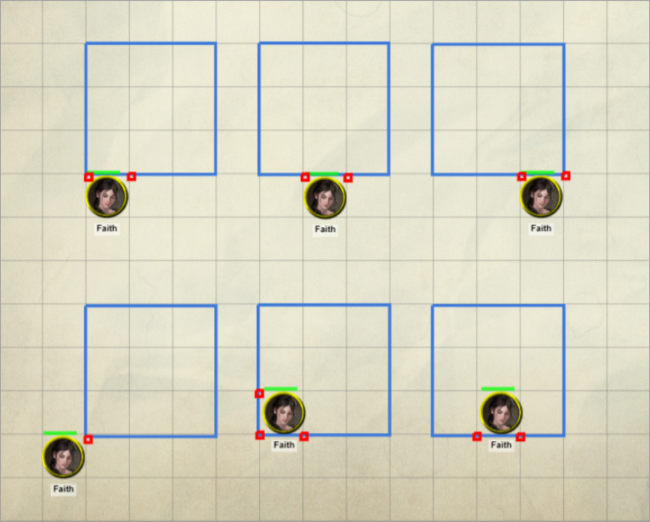 Part of an ongoing series of 5e (2014) Rules notes. See the end of the post for notes on 5.5e (2024) rules.
Part of an ongoing series of 5e (2014) Rules notes. See the end of the post for notes on 5.5e (2024) rules.
So Thunderwave (PHB 282-83) is a pretty cool spell, and usually ends up in a lot of parties’ repertoire (also in the repertoire of a lot of enemy parties). It does decent damage, an AoE, a push, and the CONstitution Save it carries makes it most useful against spellcasters. It does make a godawful racket (carrying 300 feet away, which any DM should take advantage of), but it also scales damage by spell slot.

Overall, a nifty spell. But we’re not going to talk about any of that.
Thunderwave and its Area of Effect
This came up in a game, so afterwards I did some looking into the odd Area of Effect world that is Cubes and Thunderwave.
(There’s a lot about 5e that I respect, but their AoE stuff is kind of janky in general and then the fit onto a grid map — which 5e really sort of dislikes on principle but cannot ignore because a lot of tables really love it, like ours — is even more janky.)
Thunderwave has Range: Self (15-foot cube). “A wave of thunderous force sweeps out from you. Each creature in a 15-foot cube originating from you …” blah blah effects.
So, what does that mean? How does the cube relate to the caster? You would think a Cube AoE would be easy. Yet some of the writing on it approaches being Talmudic in its intricacies to figure out what RAW means here. This is my current interpretation:
Putting together the Self and the Cube AoE
Range of Self
AoE spells that have a range of Self have a point of origin starting from the caster (PHB 202).
Cube AoE
Here’s the PHB 204 on Cube AoE (emphasis mine):
You select a cube’s point of origin, which lies anywhere on a face of the cubic effect. The cube’s size is expressed as the length of each side.
A cube’s point of origin is not included in the cube’s area of effect, unless you decide otherwise.
AoE and Grid Maps
DMG 251 notes the following on “Areas of Effect” in relation to grid maps:
The area of effect of a spell, monster ability, or other feature must be translated onto squares or hexes to determine which potential targets are in the area and which aren’t. Choose an intersection of squares or hexes as the point of origin of an area of effect, then follow its rules as normal.
And Xanathar’s echoes this, speaking of “Area of Effect on a Grid”:
Choose an intersection of squares as the point of origin of an area of effect, then follow the rules for that kind of area as normal (see the “Areas of Effect” section in chapter 10 of the Player’s Handbook).
This is one that drives me bats as DM, because everyone wants their spell to be centered in in the center of a square (in origin, in target, in range calculations), and the rule are very clear that is not the case: for where spells start from, land (if not targeting a creature), and calculating the range, it’s all about intersections.
(If you look at how Cover works on a grid, too, it’s much the same thing.)
Put it all together …
So, standing in a 5×5 grid square, any of the four corners of the square / intersections of the grid are at a range of “self” and are corners that could be the face of the cube you are going to create (including a cube that you are part of, if you are touching the outside face from the inside). Here then would be the possible arrangements I can see:

Any of the above can be rotated in increments of 90 degrees.
I.e., you can be on any of the squares outside of the cube, or on the inner squares of the cube, wherever one of the corners of your square touches (red blips) part of the perimeter (side) of the cube. But not in the very center, because you can’t reach that outer face from there.
I’ve not seen anyone actually include the bottom left “corner” example, but it seems to fit the rules to my eyes.
Insider Casting
There is some debate as whether being on the inside of the cube (bottom right-hand two examples) is allowed. I don’t read anything in the above, though, that says it isn’t. That might mean including yourself in the spell effect (but hold that thought for a moment).
Note that though you can be within the cube, for the Thunderwave spell, “the thunderous force sweeps out from you,” so you yourself are not affected when you cast it, even if you are in the area. (Which is a fancier way of saying that you, as the point of origin, are not affected by spells that have a point of origin; a point is not dimensionless, in this case.)
(But Dave, you might be saying, if the point of origin is the grid intersection you are casting from, then doesn’t the thunderous force emanate from that and, if you are inside the AoE, affect you, too? To which I say (1) remember how I said some of this stuff gets Talmudic? and (2) go away, boy, you bother me.)
When would you use a case, of being inside (not the center!) of the cube? Two use cases I can think of:
- To reduce the effective effective range to 10 feet rather than 15 feet (potentially important in an indoor combat).
- To include a tiny opponent in your own square (an edge case, but a potentially helpful one).
To sum up
So, unless anyone has any objections, that’s how I consider the area for Thunderwave to work.
 So what about with 5.5e?
So what about with 5.5e?
I’m still trying to figure that out.
Remember that in 5e (2014), grid-based combat is an optional rule. The default is Theater of the Mind, where the DM gets to be constantly juggling where everything and everyone is in order to convey it to the players so that they have some idea of what’s going on …
Sorry. Betraying my wargaming prejudices here.
Grid-based tactical maps are referenced in the 5.5e (2024) PHB, but, in more detail, in the 5.5e DMG, p. 44. These largely parallel the 5e rules (along with the confusing “well, here’s what you can do with these things, but you don’t have to, you can just use rulers and pipe cleaners and sticky notes,” but I digress).
The key here is that under “Areas of Effect,” the DMG rules say:
If the area has a point of origin, choose an intersection of squares or hexes to be the point of origin, then follow its rules as normal.
As well as:
If an area of effect covers at least half a square or hex, the entire square or hex is affected.
This is basically the same as the 5e rules. Whether a line, a cube, a sphere, or a cone, everything anchors off a grid intersection.
Except …
Emanations are weird. In 5e, these were basically “range = Self” radiused AoEs, but it was still easy enough to say, “Well, sure, choose one of the four intersections [assuming a square grid] around your character and anchor the effect there.
But while 5.5e has “range = Self” rules, a lot of those lean on Emanations, which make corner-based AoEs a bit harder to swallow:
An Emanation is an area of effect that extends in straight lines from a creature or an object in all directions. The effect that creates an Emanation specifies the distance it extends. […]
An Emanation’s origin (creature or object) isn’t included in the area of effect unless its creator decides otherwise.
That really sounds like they want an Emanation AoE to center on the focal square, not on an intersection next to it. Given the AoE definition above, that sounds incorrect, but it’s still an uncomfortable definition.
That said, I’d still require an Emanation to hook off of one of the target’s adjoining intersections, and treat it different from a sphere AoE, etc., by being mobile with the creature or object it emanates from. That keeps things consistent, if marginally janky.
But what about Thunderwave?
Well, what about it?
Oh, as a spell? It’s written up pretty much the same as the 5e version.


One thought on “D&D 5e/5.5e Rules – Spells: Thunderwave! (and other cubical-AoE range-Self spells)”